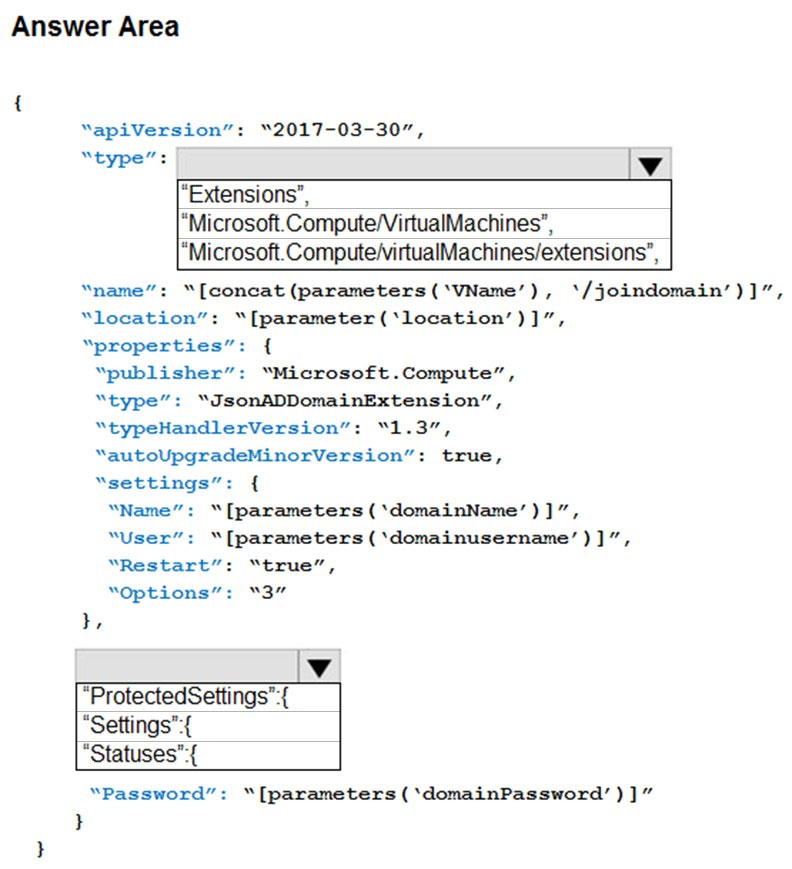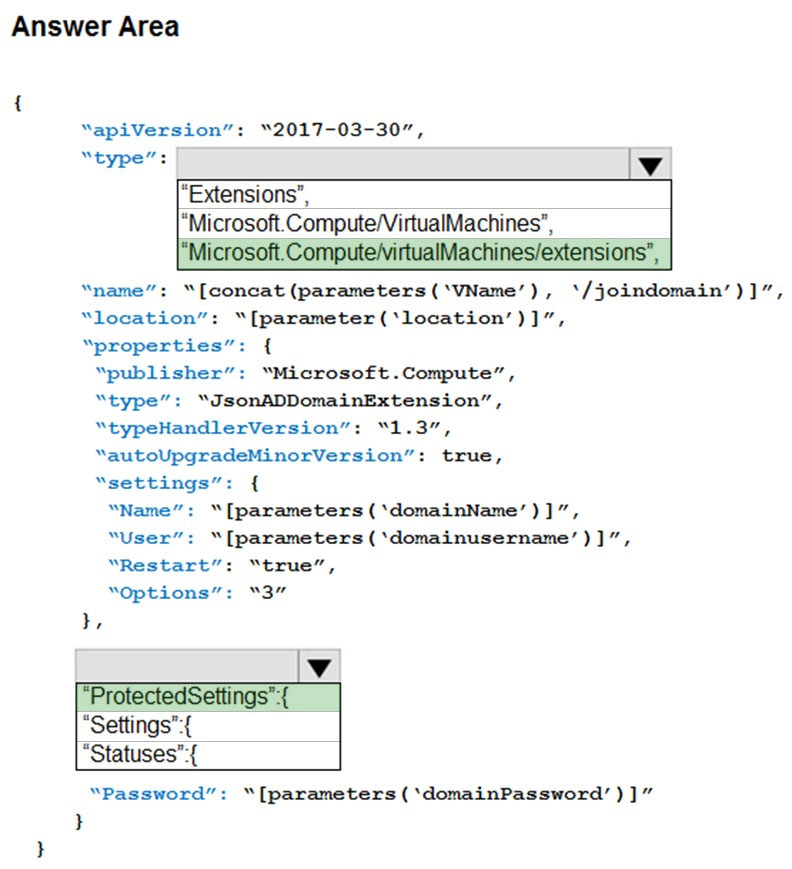You plan to deploy several Azure virtual machines that will run Windows Server 2019 in a virtual machine scale set by using an Azure Resource Manager template.
You need to ensure that NGINX is available on all the virtual machines after they are deployed.
What should you use?
Answer:
C
Use Azure Resource Manager templates to install applications into virtual machine scale sets with the Custom Script Extension.
Note: The Custom Script Extension downloads and executes scripts on Azure VMs. This extension is useful for post deployment configuration, software installation, or any other configuration / management task.
To see the Custom Script Extension in action, create a scale set that installs the NGINX web server and outputs the hostname of the scale set VM instance.
Reference:
https://docs.microsoft.com/en-us/azure/virtual-machine-scale-sets/tutorial-install-apps-template
HOTSPOT -
You have an Azure subscription. The subscription contains a virtual machine that runs Windows 10.
You need to join the virtual machine to an Active Directory domain.
How should you complete the Azure Resource Manager (ARM) template? To answer, select the appropriate options in the answer area.
NOTE: Each correct selection is worth one point.
Hot Area:
Answer:

Box 1: "Microsoft.Compute/VirtualMachines/extensions",
The following JSON example uses the Microsoft.Compute/virtualMachines/extensions resource type to install the Active Directory domain join extension.
Parameters are used that you specify at deployment time. When the extension is deployed, the VM is joined to the specified managed domain.
Box 2: "ProtectedSettings":{
Example:
{
"apiVersion": "2015-06-15",
"type": "Microsoft.Compute/virtualMachines/extensions",
"name": "[concat(parameters('dnsLabelPrefix'),'/joindomain')]",
"location": "[parameters('location')]",
"dependsOn": [
"[concat('Microsoft.Compute/virtualMachines/', parameters('dnsLabelPrefix'))]"
],
"properties": {
"publisher": "Microsoft.Compute",
"type": "JsonADDomainExtension",
"typeHandlerVersion": "1.3",
"autoUpgradeMinorVersion": true,
"settings": {
"Name": "[parameters('domainToJoin')]",
"OUPath": "[parameters('ouPath')]",
"User": "[concat(parameters('domainToJoin'), '\\', parameters('domainUsername'))]",
"Restart": "true",
"Options": "[parameters('domainJoinOptions')]"
},
"protectedSettings": {
"Password": "[parameters('domainPassword')]"
}
}
}
Reference:
https://docs.microsoft.com/en-us/azure/active-directory-domain-services/join-windows-vm-template
You have an Azure subscription that contains the resources shown in the following table.
You need to configure a proximity placement group for VMSS1.
Which proximity placement groups should you use?
Answer:
C
Resource Group location of VMSS1 is the RG2 location, which is West US.
Only Proximity1, which also in RG2, is located in West US
Note: When you assign your virtual machines to a proximity placement group, the virtual machines are placed in the same data center, resulting in lower and deterministic latency for your applications.
Reference:
https://azure.microsoft.com/en-us/blog/introducing-proximity-placement-groups/
HOTSPOT
-
You are creating an Azure Kubernetes Services (AKS) cluster as shown in the following exhibit.
Use the drop-down menus to select the answer choice that completes each statement based on the information presented in the graphic.
NOTE: Each correct selection is worth one point.
Answer:

HOTSPOT
-
You have an Azure subscription that contains an Azure Kubernetes Service (AKS) cluster named Cluster1. Cluster1 hosts a node pool named Pool1 that has four nodes.
You need to perform a coordinated upgrade of Cluster1. The solution must meet the following requirements:
• Deploy two new nodes to perform the upgrade.
• Minimize costs.
How should you complete the command? To answer, select the appropriate options in the answer area.
NOTE: Each correct selection is worth one point.
Answer:

HOTSPOT
-
You have an Azure subscription.
You create the following file named Deploy.json.
You connect to the subscription and run the following commands.
For each of the following statements, select Yes if the statement is true. Otherwise, select No.
NOTE: Each correct selection is worth one point.
Answer:

You plan to deploy several Azure virtual machines that will run Windows Server 2019 in a virtual machine scale set by using an Azure Resource Manager template.
You need to ensure that NGINX is available on all the virtual machines after they are deployed.
What should you use?
Answer:
A
HOTSPOT
-
You have an Azure subscription that contains a resource group named RG1.
You plan to use an Azure Resource Manager (ARM) template named template1 to deploy resources. The solution must meet the following requirements:
• Deploy new resources to RG1.
• Remove all the existing resources from RG1 before deploying the new resources.
How should you complete the command? To answer, select the appropriate options in the answer area.
NOTE: Each correct selection is worth one point.
Answer:

HOTSPOT
-
You have an Azure App Service web app named app1.
You configure autoscaling as shown in following exhibit.
You configure the autoscale rule criteria as shown in the following exhibit.
Use the drop-down menus to select the answer choice that answers each question based on the information presented in the graphic.
NOTE: Each correct selection is worth one point.
Answer:

You have an Azure subscription.
You plan to deploy the Azure container instances shown in the following table.
Which instances can you deploy to a container group?
Answer:
C